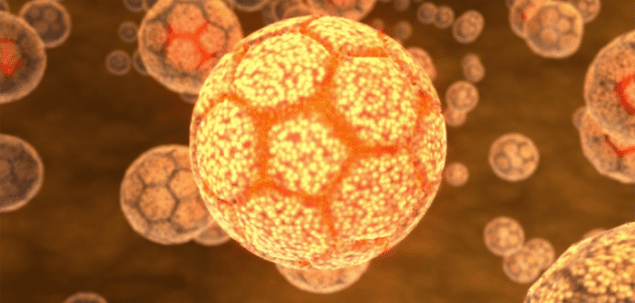
Scientists in the UK have shown for the first time that focussed ultrasound from outside the body can improve the delivery of cancer drugs to tumours in humans. In the clinical trial, the team injected 10 patients with heat-sensitive capsules filled with a chemotherapy agent and then heated tumours with ultrasound. The technique could reduce the dose of toxic drugs needed to treat cancers and lead to news ways of dealing with tumours that are hard to treat with conventional chemotherapy, according to the researchers.
Delivering an effective dose of drugs to a tumour while minimizing toxicity elsewhere in the body is a major challenge in cancer treatment. One promising idea involves using drug-filled nano-capsules. These capsules increase the half-life of chemotherapy agents in the body and are designed to accumulate – either passively or through active targeting – in tumours. But they do not always release their payload effectively.
In the latest study, described in The Lancet Oncology, Paul Lyon and colleagues at the University of Oxford conducted a 10-patient phase 1 clinical trial to test the safety and feasibility of using focussed ultrasound to heat liver tumours and trigger the release of a chemotherapy drug from heat-sensitive, lipid-based carrier.
Temperature-sensitive carrier
All 10 patients had inoperable liver tumours. Under general anaesthetic, they each received a single intravenous dose of the chemotherapy agent doxorubicin encased in a temperature-sensitive liposomal carrier. A focussed ultrasound device, operating at a frequency of 0.96 MHz, was then used to heat the target liver tumour to over 39.5°C – which is the temperature at which the capsule is design to release the drug.
In six patients the temperature of the tumour was monitored using a temporary implanted probe, and tumour biopsies were taken before and after drug infusion, and after ultrasound exposure to estimate drug concentration within the tumour at different treatment stages. In the remaining four patients, biopsies were only taken after ultrasound exposure. The researchers used predictive models to calculate the ultrasound parameters needed to heat the tumours to a temperature in the range of 39.5–43°C. The researchers say this procedure better reflects how the technique might be used in clinical practice.
Following focussed ultrasound exposure, doxorubicin concentrations within the tumours increased by an average of 3.7 times. In seven out of the 10 patients there was at least a doubling of the drug within the tumour. One patient showed an estimated nine times increase in drug concentration within their tumour after ultrasound heating.
Safe trigger
The researchers say that their results build on decades of promising preclinical research to demonstrate that it is possible to safely trigger the release of cancer drugs deep within the body using focussed ultrasound. They add that the several-fold average increase in drug concentration seen highlights the clinical potential of such techniques.
“Only low levels of chemotherapy entered the tumour passively. The combined thermal and mechanical effects of ultrasound not only significantly enhanced the amount of doxorubicin that enters the tumour, but also greatly improved its distribution, enabling increased intercalation of the drug with the DNA of cancer cells,” explains Lyon.
This opens the way not only to making more of current drugs but also targeting new agents where they need to be most effective
Mark Middleton
“A key finding of the trial is that the tumour response to the same drug was different in regions treated with ultrasound compared to those treated without, including in tumours that do not conventionally respond to doxorubicin,” adds Oxford’s Mark Middleton. “The ability of ultrasound to increase the dose and distribution of drug within those regions raises the possibility of eliciting a response in several difficult-to-treat solid tumours. This opens the way not only to making more of current drugs but also targeting new agents where they need to be most effective.”
Precise anatomical location
Jeff Karp, Professor of Medicine at the Brigham and Women’s Hospital, in Boston, US, told Physics World that “this is a very well performed study in human patients”. He adds: “Although some limitations exist, this study demonstrates that by using thermo-sensitive liposomes in combination with ultrasound, it’s feasible to safely enhance the intratumoral delivery of therapeutic molecules to a precise anatomical location in human patients and improve the therapeutic outcome.”
Karp says that the next step in this line of research is to test this approach in other solid tumours and with other drugs. He adds that the development of ultrasound devices that can precisely target different types and sizes of tumours, and ultrasound-sensitive delivery vehicles may further improve drug delivery and reduce side effects.



